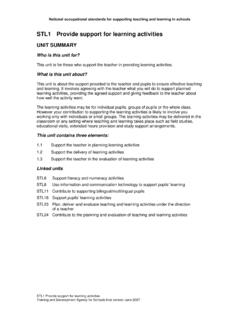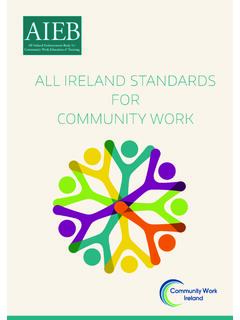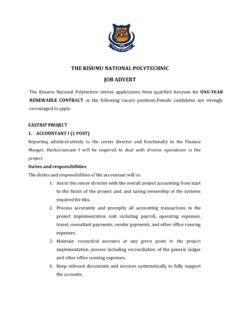Transcription of National Occupational Standards for Supporting Teaching ...
1 National Occupational Standards for Supporting Teaching Learning 1 of 21. This booklet is for school leaders and those Supporting the learning and development of support staff in schools. It explains how these Standards can help with a wide range of staff development activities. Contents About the National Occupational Standards .. 3. Online 3. Key benefits of using the National Occupational Standards and online guidance3. Skill mix reviews .. 4. Recruitment .. 4. Performance Review .. 5. Training & Development .. 6. Career progression .. 6. Who developed the National Occupational Standards and online guidance for staff Supporting Teaching and learning?
2 7. What are the Standards and the accompanying online guidance? .. 7. Are support staff expected to meet all the Standards ? .. 7. Who do the Standards apply to? .. 7. What are the benefits of using the Standards and accompanying online guidance? .. 7. What about Standards for school support staff who are not Supporting Teaching and learning?.. 8. How do the Standards relate to the Standards for higher level Teaching assistants (HLTAs) and teachers? .. 8. I already know what I want my staff to do why should I bother with these Standards ? .. 8. Is this going to create more expectations for support staff training? .. 9. Unit Descriptions.
3 10. Abbreviations .. 20. NB. Throughout this booklet, staff Supporting Teaching and learning are referred to as support staff the National Occupational Standards are enabling schools to adapt, change and improve, and develop the specific skills they need to support excellent Teaching and learning opportunities for all young people in the 21st century.. Betty Renshaw MBE, School Business Manager Woodchurch 2 of 21. About the National Occupational Standards Support staff in schools carry out increasingly diverse and responsible roles. Schools have identified that this has an impact on their training and development needs. TDA worked with school leaders to develop the National Occupational Standards for Supporting Teaching and learning.
4 Using these Standards can save you valuable time, because they provide a foundation from which to work when considering the recruitment, development and progression of support staff. The Standards describe what support staff need to do, know and understand in their roles. They support and enhance the day-to-day activities of school leaders and support staff, and align with National expectations and qualifications. Using the Standards will help you to develop the capacity and capability of your whole school team. Online guidance The TDA has developed clear and practical online guidance to the Standards , which explains how they will help you with a wide range of staff development activities.
5 The online guidance is not prescriptive. Different schools have different needs and priorities, and the Standards provide and point to flexible resources and tools that reflect this. You can select from a range of options to meet the needs of your school, knowing that the Standards have the support of your peers. Key benefits of using the National Occupational Standards and online guidance The Standards are based on the roles and responsibilities of support staff in today's schools. Together with the guidance, they enable you to manage the different stages of support staff recruitment, development and progression more effectively. It is not necessary to use the Standards to inform every stage.
6 School leaders and support staff can access the Standards most appropriate to their needs depending on the stage they are at. 3 of 21. The Standards can help you manage each of the stages shown in the diagram below. The following pages set out in more detail how the Standards can be used. Skills mix Recruitment Performance Training and Career review review development progression Skill mix reviews The first stage of this process is likely to be identifying the skills your school needs. The TDA's school improvement planning framework may help you with this visit Once your school's needs have been identified, the Standards and accompanying guidance enable you to carry out skill mix reviews to identify the range of skills your support staff already have, and where there are skills gaps.
7 You can then make decisions about addressing these gaps through training and development and/or recruitment. Decisions about skill mix requirements and how jobs can be designed to meet these requirements are based on the circumstances and needs of individual schools, their staff and pupils. These will change over time, as new priorities emerge and initiatives are implemented. Recruitment The Standards include details of the knowledge and activities required for staff Supporting Teaching and learning to carry out their roles successfully. They describe the expected levels of performance, and related knowledge and understanding, which apply to the role holder.
8 They can help you to design job roles, create job descriptions and adverts, and improve recruitment and selection. The online guidance provides examples of support staff job descriptions which use the Standards . The guidance also links to Standards -setting bodies for support staff not directly involved in Teaching and learning, such as cleaners and catering staff. 4 of 21. Performance review Everyone works to a standard of some kind their own, their company's or their profession's. What most firms and most individuals want is a sense of what competent performance is, a level of performance which means that individuals make best use of their knowledge and skills, and their employers get value for money.
9 NOS are therefore a natural starting point for appraising peoples performance, ensuring they understand what they are supposed to achieve, giving them feedback on how well they are doing, setting fresh challenges and determining improvement or development needs. Of course you may already have an appraisal and development process, but NOS are flexible and adaptable and can be used selectively or as a whole, and can complement existing performance review systems. Training and development The Standards can be used as the basis of a training needs analysis which will help you to identify areas for development. This is important, as support staff will be at different stages in their careers, with different needs, skills gaps and areas for development.
10 The Standards provide objective measures to judge existing skills and knowledge against development needs. They also help school leaders develop training tailored to specific needs. Using the Standards to define development needs means that those who plan and deliver training courses or other development opportunities can link the design and content directly to the needs of the individual. The Standards can also be used to measure the outcome of training and development delivery. The TDA online unit selection tool can help you with these processes. It will take you and your support staff through a checklist, describing the wide range of responsibilities they may have.















